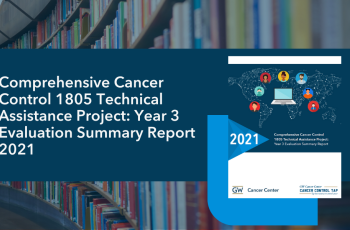This work was supported by Cooperative Agreement #NU58DP007539-01 from the Centers for Disease Control and Prevention (CDC).
Articles, Reports, Briefs
This report provides a brief overview of GW Cancer Center comprehensive cancer control technical assistance project, "Building Cancer Control Capacity: Scaling Evidence to Practice to Advance Health Equity." The purpose of this summary is to give an outline of activities and progress in Year 03 (…
At CDC, we are committed to ensuring every person has the opportunity to live a healthy life. To that end, CDC—as the nation’s leading public health agency—has established this web portal, “Racism and Health” to serve as a hub for our activities, promote a public discourse on how racism negatively…
Active People, Healthy Nation (SM) is an initiative led by the US Centers for Disease Control and Prevention to improve the health of 27 million Americans by 2027 by increasing their level of physical activity.
Rural America is economically, socially, culturally, geographically, and demographically diverse. This multidimensional diversity presents complex challenges and unique opportunities related to delivering health care and improving health outcomes and health equity in rural communities.
For 22 years, the American Lung Association has analyzed data from official air quality monitors to compile the State of the Air report.
This policy brief from the WWAMI Rural Health Research Center addresses geographic access to health care for rural Medicare beneficiaries in five states.
Comprehensive cancer control programs are working in communities across the nation to promote healthy lifestyles, support recommended cancer screenings, educate people about cancer symptoms, increase access to quality cancer care, and enhance cancer survivors’ quality of life. These stories…
Data brief showing cancer incidence rates for American Indian and Alaska Native (AI/AN) populations living in select urban areas vary by geographic region. Rates in certain regions, such as Alaska and the Southern Plains, are higher in urban AI/AN compared with White populations.
Cancer was the second leading cause of death, after heart disease, in the United States in 2019. In 2019, there were 599,601 cancer deaths; 283,725 were among females and 315,876 among males.
he National Viral Hepatitis Progress Report provides information on progress in the implementation of recommended interventions and the impact these interventions are having on prevention of viral hepatitis transmission, disease, and associated mortality.
